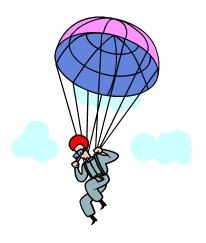Parachute to safety
A parachute is a large, umbrella-shaped fabric canopy used to slow the fall of a person or object from an aircraft or any other great height.
 Objects falling freely through the atmosphere can attain a terminal velocity (top speed) of more than 118 miles per hour. No one is likely to survive striking the ground with such impact.
Objects falling freely through the atmosphere can attain a terminal velocity (top speed) of more than 118 miles per hour. No one is likely to survive striking the ground with such impact.
The operation of a parachute is based on two forces that act on any falling object:
- Gravity pulls the object toward the earth.
- Air resistance pushes upward against the object's downward movement.
By using a parachute, the air resistance is increased thus reducing the speed of the falling object to insure a safe landing. Because the pull of gravity is much stronger than the air resistance, the parachute can only slow the speed of the falling object, it cannot offset gravity's force.
Larger surfaces offer greater resistance to the air. Thus, the larger the parachute's surface, the more air resistance it meets and the slower the object falls.
Soft Landing Experiment
"George Files" by Parenting the Next Generation

|
Objects falling freely through the atmosphere can attain a terminal velocity (top speed) of more than 118 miles per hour. No one is likely to survive striking the ground with such impact.